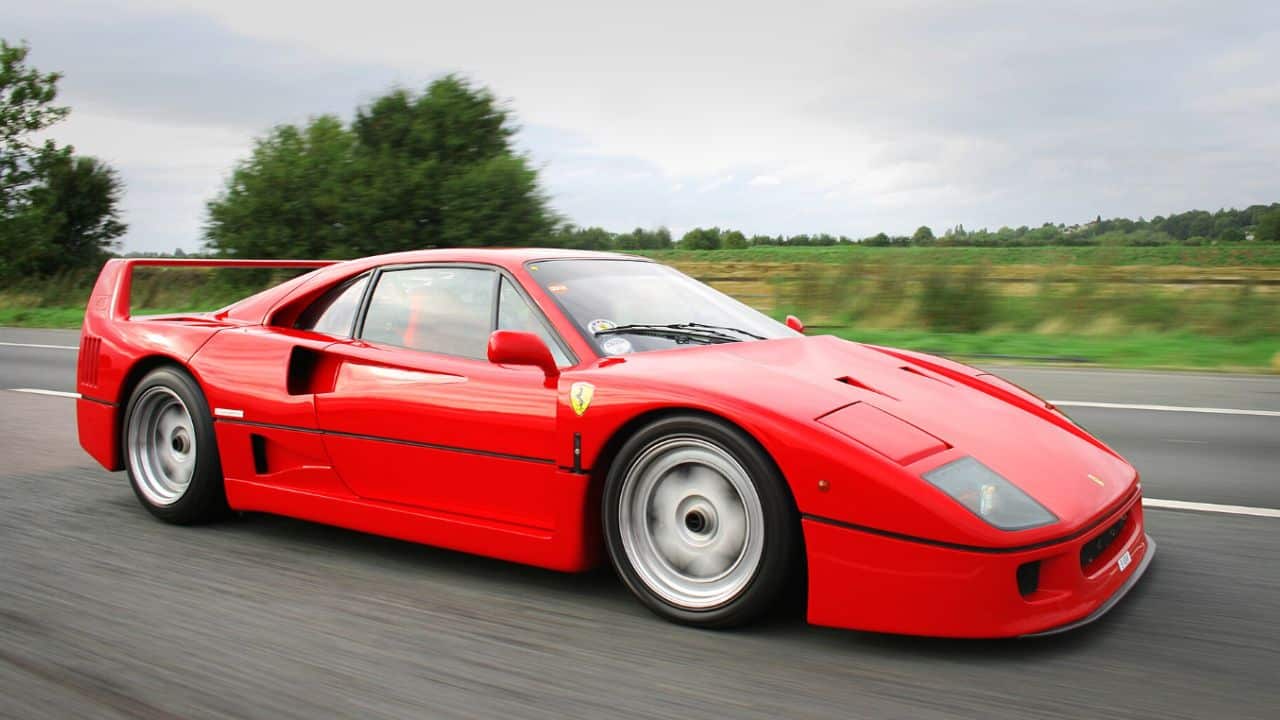24 Coolest Cars of the Past 50 Years

Five decades ago, the automotive world had just entered the Malaise Era, which effectively killed all the American performance cars.
Luckily, we’ve come a long way, and manufacturers have built countless cool cars since then.
We gathered some of the best, most fun, stylish, or game-changing models from the mid-1970s to the present. This list is by no means exhaustive, as we could easily have come up with 50 iconic cars from this period.
1974 Lamborghini Countach

In 1966, Lamborghini created the first mid-engined supercar when it launched the Miura, but its successor, the Countach, was an even bigger hit. Launched in 1974, the Countach literally became the poster car for an entire generation of young gearheads.
Low, wide, and wedge-shaped, the Lamborghini Countach didn’t resemble anything else on the road. With time, it grew even wider as it gained fender flares, and with the front and rear wings fitted, it looked like a fighter jet on wheels. Thanks to its mid-mounted V12 engine, that’s exactly what it sounded like, too.
1984 Audi Sport Quattro

Audi revolutionized the automotive industry when it launched its Quattro in the early 1980s. It wasn’t the first car with AWD, but it certainly helped popularize it, largely thanks to the Quattro’s rally dominance.
Four years after the Ur-Quattro arrived, Audi took things up a notch with the Sport Quattro, a homologation special for Group B rallying. It had a shorter wheelbase, a turbocharged five-cylinder engine with 300-hp, and, of course, all-wheel drive.
1986 Porsche 959

The Porsche 959 is another homologation special, and somewhat surprisingly, it was also supposed to be a Group B rally car. Unfortunately, the Group B class no longer existed when the 959 was ready, so Porsche decided to race it in the Paris to Dakar rally and at the Le Mans 24-hour race instead.
Porsche packed the 959 with tech, including hydraulically height-adjustable suspension, a crawler gear, sequential turbos, and a programmable AWD system. With 444-hp, it came very close to the 200 mph barrier, with the needle stopping at 197 mph.
1987 Ferrari F40

One year after Porsche had introduced the 959, Ferrari launched the F40, and the two were immediately seen as arch-rivals. The F40 was the last Ferrari Enzo personally approved, and seeing as he preferred race cars to road cars, we’re sure he loved this one.
This Ferrari didn’t pretend to be luxurious; it was built to go fast, and that’s it. With a turbocharged 2.9-liter V8 engine churning out 480-hp, the F40 smashed through the 200 mph barrier. Its paint was so thin that you could see the kevlar weave beneath it, and the lightweight louvered plexiglass window at the back provided an excellent view of the magical engine.
1990 BMW M3 Sport Evo

In 1986, BMW introduced a car that would forever change the automotive world. The E30 M3 was a homologation special built to compete in FIA Group A races. While the M3 resembled the regular 3 Series Bimmer, the two only shared the hood, roof panel, and grille.
Under the hood, the E30 BMW M3 had a 2.3-liter four-cylinder unit that produced 192-hp in the U.S. version. No other naturally aspirated car for sale in the States at the time made more power per liter. However, in 1990, BMW updated the M3 for the third time, and it now received a 2.5-liter engine producing 235-hp, and it was lighter, too.
1990 Mercedes-Benz 190E Evo II

Mercedes-Benz tried to compete with the E30 BMW M3 in DTM, but the regular Cosworth-fettled 16-valve version couldn’t keep up, and to make matters worse, BMW kept updating and upgrading it with the Evolution models.
In 1989, Mercedes decided to take things to the next level and built the awesome 190E Evolution, which would later be referred to as the Evo I, but it still wasn’t enough to beat the Bavarians. A couple of years later, the muscular 190E Evo II arrived, featuring wider arches, a massive rear wing, and a bunch of other upgrades. Mercedes finally beat BMW, and from now on, their racing program was handled by AMG.
1990 Mazda Miata

How can we possibly list the coolest cars without including the Mazda Miata?! Mazda took all the best ingredients from classic British sports cars and added a dash of legendary Japanese reliability.
There are now four generations of the Miata to choose from, and while the later versions have larger, more powerful engines, the first one is the only version with pop-up headlights.
1992 Dodge Viper

When Dodge introduced the Viper, it also popularized the V10 engine, which was primarily found in diesel trucks until now. The 8.0-liter unit under the long hood of the first-gen GTS model produced an impressive 450 wild American horses.
With time, the V10 engine grew to 8.3 and 8.4 liters, and while Dodge did eventually include some basic safety features and driver aids, the Viper would bite if it wasn’t respected.
1990 Acura NSX

Honda blew the competition out of the water when it released its first supercar, the NSX, sold under the Acura brand in the States. Supercars had always been fickle beasts that required lots of TLC to run properly, and they were difficult to drive, but that wasn’t the case with the NSX. It was as easy to drive and maintain as a Honda Accord.
The NSX packed a 3.0-liter V6 engine, and with 270-hp, it wasn’t as powerful as the competition. However, Formula 1 legend Ayrton Senna helped develop the chassis, and it would outperform most cars. Even today, the original NSX is considered one of the best driver’s cars money can buy.
1992 McLaren F1

Gordon Murray, the man behind the McLaren F1, used the Acura NSX’s handling as the yardstick when the F1 was developed. When it arrived in 1992, the McLaren F1 packed more technology and performance than any other supercar.
It had a 3-seater cabin featuring a central driving position, carbon fiber construction, a BMW V12 engine, and an engine bay covered in real gold. The F1 became the world’s fastest production car, and even today, more than 30 years after it first saw the light of day, it’s still the fastest naturally aspirated car ever made.
1993 Toyota Supra

Initially, the Toyota Supra was a trim level of the Celica, but in the 1980s, it became a standalone model. In 1993, Toyota introduced the Mk4 Supra, which has since become one of the most legendary Japanese cars ever, largely because of its bulletproof and highly tunable turbocharged 2JZ inline-six engine.
While it wasn’t a bestseller during its years in the American market, the Supra shot to superstardom after appearing in the Fast & Furious franchise.
1993 Porsche 993 GT2

Porsche built the 993 GT2 as an RWD homologation special of the 993 Turbo. By deleting the AWD setup and giving it a more stripped-down interior, the GT2 was significantly lighter than the standard Turbo model. Thanks to higher boost, it was also more powerful, producing 424-hp.
Porsche also cut back the Turbo’s fenders and replaced them with bolt-on plastic units to fit even wider wheels and tires. This also made it easier to repair the fenders if they were damaged in a race. The chances of seeing one of the GT2 road cars on a track are fairly slim nowadays, though. With only 57 units built, these cars are highly sought after by collectors and spend most of their time locked away.
1999 Nissan Skyline GT-R

The R32 Nissan Skyline GT-R was so good that it was banned from several racing series. Ten years later, when the R34 version arrived, everything was turned up to 11. Due to the Japanese gentlemen’s agreement, no Japanese car could have more than 280-hp, so that was the R34’s official power figure.
In reality, the R34 Skyline GT-R’s twin-turbocharged 2.6-liter inline-six delivered around 320-hp. All that power was sent to all four wheels via a six-speed manual transmission. It was Paul Walker’s weapon of choice in his last couple of F&F movies, and prices have since skyrocketed out of reach to most enthusiasts.
1999 Pagani Zonda

Pagani stepped onto the supercar scene with the Zonda in the 1990s. As they were a small, boutique manufacturer, they didn’t have the resources to develop their own engines and instead went with the 6.0-liter V12 from Mercedes-Benz.
The Merc V12 had previously been used in the SL600, but AMG worked its magic on it before sending it to Pagani. It produced roughly 400-hp in the Zonda C12 but increased to almost double that in the 790-hp Zonda Revolución from 2012.
1999 Honda S2000

Honda shocked the automotive world when it unveiled the S2000! An affordable open-top sports car with the highest specific power output for a naturally aspirated engine was a dream come true for many enthusiasts.
Early models had a 2.0-liter engine that needed to be revved all the way to the redline, but Honda addressed some of its shortcomings by increasing the volume to 2.2 liters in later models. S2000 prices have skyrocketed in recent years, so finding a good one for sensible money is nigh-on impossible.
2000 Ariel Atom

You’ll struggle to find a sports car that’s more minimalistic than the Ariel Atom. What it lacks in features and equipment, it more than makes up for in sheer fun. In fact, some would argue that this is the best British sports car of all time, and if you’re only looking for speed and adrenaline, they’re right!
The bare-bones Atom offered blistering speed and acceleration thanks to its rear-mounted turbocharged Civic Type-R engine that pumps out more than 300 wild ponies. It’s safe to say that there are more sensible daily drivers out there, though.
2004 Porsche Carrera GT

Porsche is best known for its boxer engines, so when they announced that the Carrera GT would have a V10, gearheads were both shocked and excited. The Carrera GT was one of the last analog supercars, which meant it was quite a handful to drive.
Sadly, it’s now famous for being involved in Paul Walker’s final ride, and it nearly took out Jay Leno years before that. On the plus side, the Carrera GT’s V10 engine sounds incredible, and the mid-mounted 5.7-liter unit sends 611 prancing German horses to the rear wheels. We’re half in awe and half terrified of this beast.
2005 Ford GT

In 2005, Ford launched the GT40’s spiritual successor, the Ford GT. It was the first Blue Oval supercar since the original GT40 (not counting the GT90 concept car) from the 1960s. While it looked similar to its Le Mans-dominating predecessor, it was a cutting-edge supercar underneath the retro styling.
The Ford GT could easily go up against the best European supercars of its time, such as the Porsche Carrera GT and Ferrari Enzo. However, it wasn’t a Le Mans winner like the models before and after it. Surprisingly, sales were slow, and only after it was discontinued did it become a highly sought-after model by collectors.
2005 Bugatti Veyron

The Bugatti Veyron EB 16.4 was unlike any other car before it. It had a mid-mounted quad-turbo, 8.0-liter W16 engine that produced 987-hp. In “standard” guise, it could reach a 253 mph top speed, which was increased to 267.86 with the Super Sport version.
The Veyron went on to inspire various other hypercar manufacturers, and while there have been several models that are both faster and more powerful, the Veyron is still the one people remember. Top Gear named it the “2000s Car of the Decade” and the “Best Car Driven All Year” in 2005, which proves just how good it was.
2006 Mini John Cooper Works GP

BMW bought the Mini brand, and in 2001, they launched the cool and stylish New Mini. Until 2006, the Mini Cooper S, with its 160-hp+, was the most powerful version, but that changed when the John Cooper Works GP arrived.
The GP was a lightweight, semi-race-prepped model with a stripped-out interior, a new body kit — including a much larger and more stylish rear wing — improved suspension, and power increased to 218-hp.
2009 Lexus LFA

The Lexus LFA is perhaps the best supercar to ever emerge from the land of the rising sun, but its screaming exhaust note alone would be enough to earn it a spot on this list. Like many other modern collector’s items, the LFA wasn’t a huge success when it was available. Try buying one today, though.
Its 4.8-liter V10 engine produces 553–563-hp, depending on the version, and 354 lb-ft of torque. That’s enough to launch the LFA from 0 to 60 mph in just 3.7 seconds and on to a top speed of 202 mph.
2009 Aston Martin V12 Vantage

The Aston Martin Vantage arrived in 2005, and it’s undoubtedly one of the best models the British company has ever made — especially the V12 version that arrived in 2009. In combination with the excellent chassis and the beautiful styling, the V12 Vantage is one of the best driver’s cars available.
Early cars had an automated manual transmission, and the 5.9-liter engine produced 510 horsepower. The later V12 S made 565 horsepower, and the V600 had 595-hp. In reality, it doesn’t matter which version you drive, as they’re all excellent!
2012 McLaren 12C

Today, McLaren is a well-known supercar manufacturer, but that’s all thanks to the 12C, the first McLaren road car since F1 production ended in the 1990s. The 12C has a carbon fiber composite chassis and a twin-turbocharged 3.8-liter V8 engine producing around 620-hp.
McLaren developed the car using Top Gear’s test track, where it set the second-fastest lap time when it debuted. It also lapped the Nürburgring in 7 minutes and 28 seconds. After three years in production, McLaren had built and sold over 3,400 12Cs.
2023 Chevrolet Corvette Z06

There have been plenty of cool and powerful Corvettes over the last 50 years, but we think the latest Z06 is one of the greatest of them all.
Thanks to a mid-mounted flat-plane crank V8 engine churning out a whopping 670-hp, the Corvette is now a proper supercar. While it’s not exactly cheap, it’s still a bargain, considering it’ll keep up with European exotics that cost three times as much.





